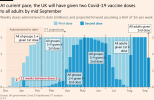Well that depends on what you call ‘quickly’.No they wouldn't catch it quickly. There would be too many people vaccinated or who'd already had it to allow for quick spread. It really isn't as easy to catch as people think.
The models I’ve seen show that with a progressive removal of all restrictions between early Feb and July, and a 60% vaccine efficacy for infection transmission, we’d have a big wave of infections in early autumn, peaking at about twice the level we saw in early January. The assumptions in that model are conservative - vaccine take up is better than expected, as is the rate of vaccination, and the efficacy is slightly better. We are also going to be a month later in restriction easing, and I suspect it will be gently, gently at first. That research needs updating with better assumptions - and I bet there is someone tousling his hair over that very data in No 10 right now.
The people I know in this field have been pretty consistent in their message that we will have another and final bout of infections (and, sadly, deaths) in Sept/Oct this year. The size of it depends on how many are vaccinated before we significantly ease restrictions (ie the rate of vaccination take up, the date of easing, and how they are eased), and the vaccine efficacy. Various levels to pull in the model, and the end result is how many extra tens of thousands of people end up dead by the at the end of the year.
It’s simple, but brutal. Not a decision I would want to have to take.

